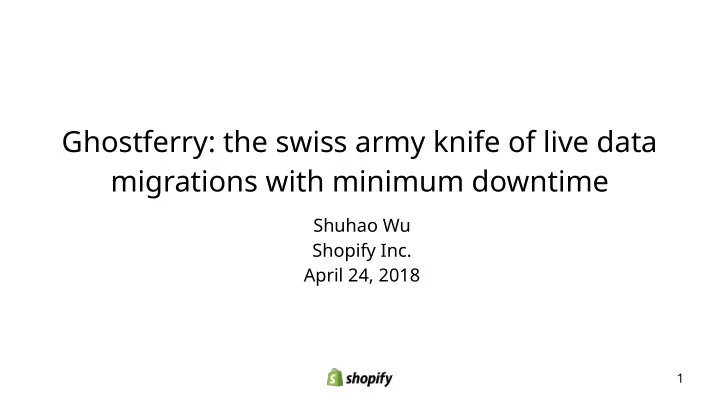

Ghostferry: the swiss army knife of live data migrations with minimum downtime Shuhao Wu Shopify Inc. April 24, 2018 1
Data Migration 2
Data Migration 3
Data Migration Between MySQL Servers Data Copy: mysqldump/Percona XtraBackup ● Data Synchronization: MySQL replication ● Minimum granularity for the data copied: a single table ● Remark ● – Small datasets: Doable – Large and busy datasets: no standard procedures 4
Data Migration Between DBaaS Providers Data Copy: mysqldump ● Data Synchronization: MySQL replication ● Minimum granularity for the data copied: a single table ● Remark ● – Percona Xtrabackup not usable due to lack of FS access – Proprietary interface to CHANGE MASTER 5
Objectives of Ghostferry Traditional Ghostferry Large downtime w/o filesystem access Low downtime with any configuration Complex workflow Single command Move at minimum a whole table Move arbitrary rows 6
Data Migration via Ghostferry Data Copy: SELECT from source; INSERT into target ● Data Synchronization: Reads binlogs from source; ● INSERT/UPDATE/DELETE on target Minimum granularity for the data copied: a single row ● Remark ● – Constant downtime for dataset of any size on order of seconds – Easy to use: a single command is enough to migrate all data 7
Process of Moving Data From Source → Target Thread 1: Follow binlog of source and replay on target . ● 8
Process of Moving Data From Source → Target Thread 1: Follow binlog of source and replay on target . ● Thread 2: SELECT FOR UPDATE on source and INSERT into target . ● – Can be done in parallel 9
Process of Moving Data From Source → Target Thread 1: Follow binlog of source and replay on target . ● Thread 2: SELECT FOR UPDATE on source and INSERT into target . ● Thread 3: Wait for Data Copy (Thread 2) to complete. ● Thread 3: Wait for pending binlog entries to be low. ● 10
Process of Moving Data From Source → Target Thread 1: Follow binlog of source and replay on target . ● Thread 2: SELECT FOR UPDATE on source and INSERT into target . ● Thread 3: Wait for Data Copy (Thread 2) to complete. ● Thread 3: Wait for pending binlog entries to be low. ● Externally: Set source to READONLY and flush writes. ● 11
Process of Moving Data From Source → Target Thread 1: Follow binlog of source and replay on target . ● Thread 2: SELECT FOR UPDATE on source and INSERT into target . ● Thread 3: Wait for Data Copy (Thread 2) to complete. ● Thread 3: Wait for pending binlog entries to be low. ● Externally: Set source to READONLY and flush writes. ● Thread 1: Finish replaying pending binlog entries on target . ● – Source == target , can use verifier to confirm. 12
Process of Moving Data From Source → Target Thread 1: Follow binlog of source and replay on target . ● Thread 2: SELECT FOR UPDATE on source and INSERT into target . ● Thread 3: Wait for Data Copy (Thread 2) to complete. ● Thread 3: Wait for pending binlog entries to be low. ● Externally: Set source to READONLY and flush writes. ● Thread 1: Finish replaying pending binlog entries on target . ● – Source == target , can use verifier to confirm. Externally: Notify application to switch to target DB. ● 13
Process of Moving Data From Source → Target Thread 1: Follow binlog of source and replay on target . ● Thread 2: SELECT FOR UPDATE on source and INSERT into target . ● Thread 3: Wait for Data Copy (Thread 2) to complete. ● Thread 3: Wait for pending binlog entries to be low. ● Externally: Set source to READONLY and flush writes. ● Cutover: Thread 1: Finish replaying pending binlog entries on target . Downtime ● – Source == target , can use verifier to confirm. Occurs Here Externally: Notify application to switch to target DB. ● 14
Requirements for Ghostferry Hard requirement for data consistency ● – Full-image row-based replication For now: ● – No schema migration during Ghostferry run – Integer primary keys only 15
Implementation of Ghostferry Core: Go library ● – Customize your data migration run via a custom app – Allows for arbitrary data filtering Standard application: ghostferry-copydb ● – Moves at least a single table 16
Implementation of Ghostferry 17
Correctness of Ghostferry Designed with the aid of formal methods (TLA+) ● Constructed finite model of the algorithm ● – Found and fixed subtle data corruption bug – Warning: Finite model != proof of correctness What did we gain? ● – Increased confidence of correctness – High level formal documentation 18
Uses of Ghostferry Shopify moved TiBs of data with Ghostferry ● – Extract some tables into its own database – WHERE sharding_key = X: rebalanced 70+ TiBs of sharded data between different nodes Advanced possible uses: ● – Cloud providers can build turn-key data import tool via Ghostferry – Use with ProxySQL to enable zero downtime migrations 19
Thank you! Open sourced under the MIT License ● https://github.com/Shopify/ghostferry ● Related work: ● – https://github.com/github/gh-ost – Das, Sudipto, et al. "Albatross: lightweight elasticity in shared storage databases for the cloud using live data migration." Proceedings of the VLDB Endowment 4.8 (2011): 494-505. Questions? ● 20
Ghostferry Copy Process in TLA+ fair process (ProcTableIterator = TableIterator) variables lastSuccessfulPK = 0, currentRow; { tblit_loop: while (lastSuccessfulPK < MaxPrimaryKey) { tblit_rw: currentRow := SourceTable[lastSuccessfulPK + 1]; if (currentRow # NoRecordHere) { TargetTable[lastSuccessfulPK + 1] := currentRow; }; tblit_upkey: lastSuccessfulPK := lastSuccessfulPK + 1; }; } 21
Ghostferry Invariants in TLA+ SourceTargetEquality == (\A self \in ProcSet: pc[self] = "Done") => (SourceTable = TargetTable) VerifcationFailIfDiferent == /\ (\A self \in ProcSet: pc[self] = "Done" /\ (SourceTable # TargetTable)) => (VerifcationFailed = TRUE) 22
Recommend
More recommend